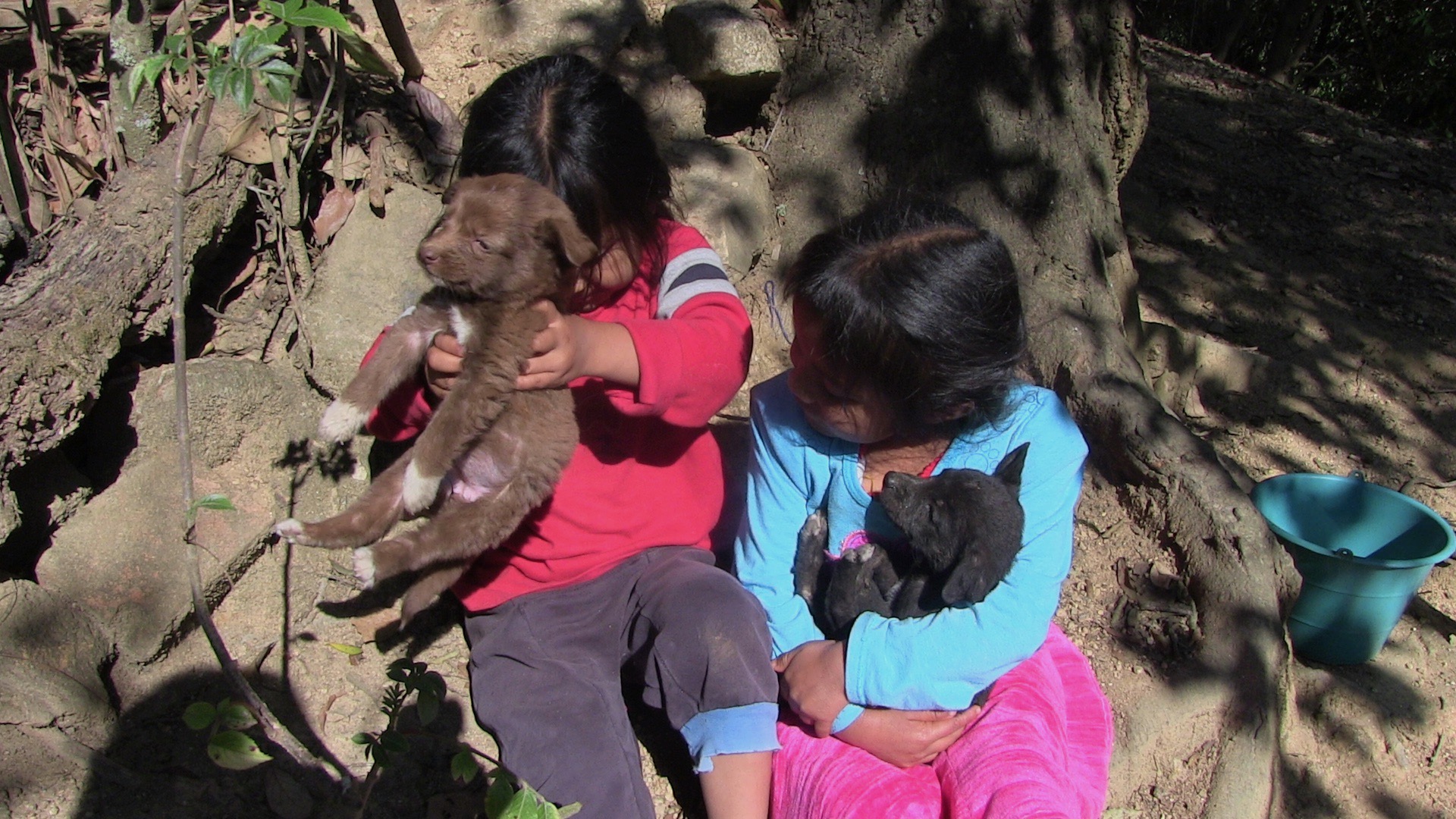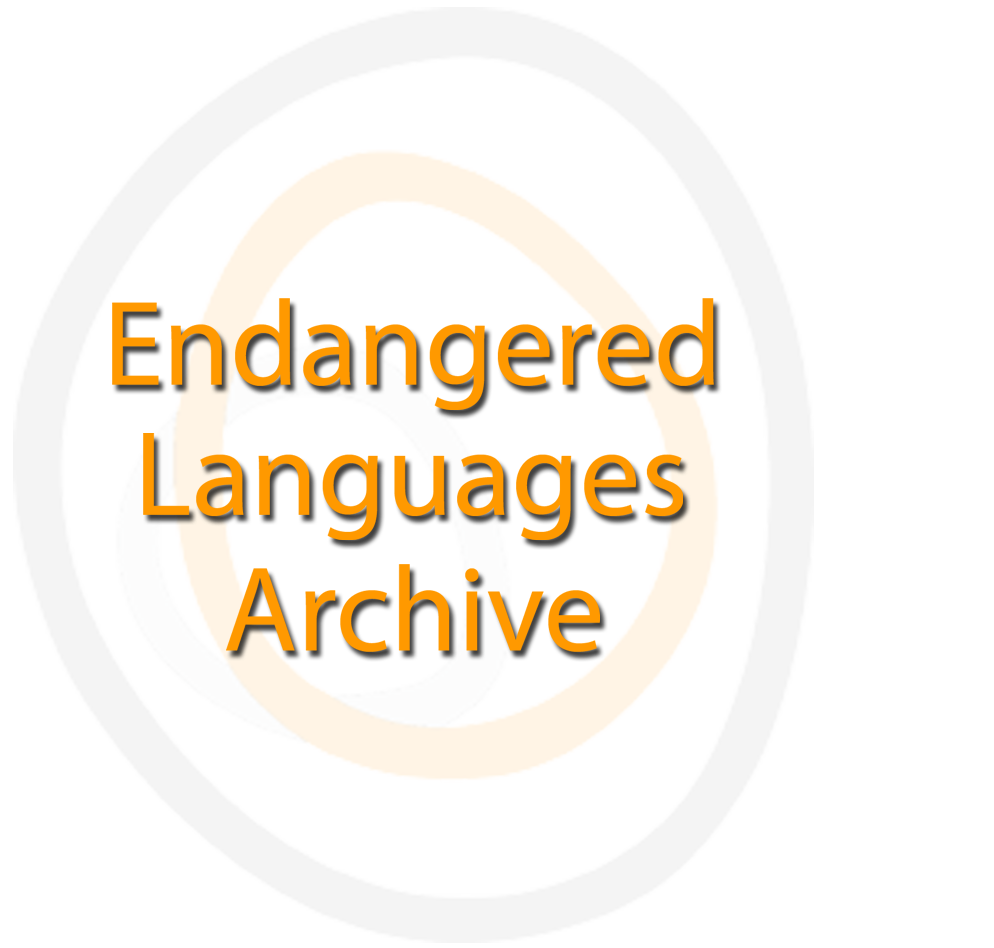Documenting Sign Language Structure and Language Socialization in the San Juan Quiahije Chatino Signing Community

Two Chatino girls are playing with puppies in their backyard. Photo of Angelica and Martha by Lynn Hou, 2015. Click on image to access collection.
| Language | San Juan Quiahije Chatino Sign Language |
| Depositor | Lynn Hou |
| Affiliation | University of California, Santa Barbara |
| Location | Mexico |
| Collection ID | 0575 |
| Grant ID | SG0186 |
| Funding Body | ELDP |
| Collection Status | Collection Online |
| Landing Page Handle | http://hdl.handle.net/2196/718d2dd5-ec29-40f4-8f5e-d1aa490a22be |
Summary of the collection
This collection contains records of an ethnographic study of some of the linguistic, cognitive, and social elements of a constellation of family sign languages used in an indigenous Mesoamerican (Chatino) community in the San Juan Quiahije municipality in Oaxaca, Mexico. The researcher, Lynn Hou, conducted this project from June 2014 to June 2015, significantly expanding an early project archived in a separate ELAR deposit: 0355, ‘Documenting Chatino Sign Language’.
Group represented
The Chatino people are the traditional inhabitants of an area of contemporary Oaxaca, Mexico, stretching from the Oaxaca Valley to the Pacific Coast. The Chatinos of the San Juan Quiahije municipality are distinguished from their neighbors by using a Chatino variety that bears the municipality’s name. There are approximately 3,600 residents of the municipality, 13 of whom are known to be deaf. These community members, along with their hearing family members, are have developed a constellation of family sign languages. Researchers call this constellation of languages, San Juan Quiahije Chatino Sign Language. Hearing people in the community call both signing in the language and gesturing, ‘making hands’.
Language information
San Juan Quiahije Chatino Sign Language (SJQCSL) is a recently identified sign language isolate that emerged among deaf people and their families in an indigenous Chatino community in the San Juan Quiahije municipality of Oaxaca, Mexico. The age of the language is estimated to be at least 50 years old, based on the approximate age of the oldest living deaf signer. As of June 2015, the municipality has a population of approximately 3,600 people, and out of this population, 11 people are people are deaf. The deaf community members are distributed across 5 families in co-residence, each of which has developed their own signing practices. Since many of the families’ signing practices overlap due to the sharing of conventional gestures and exchange of signs through recurring encounters of different signers, the name SJQCSL pertains to the constellation of family sign languages in the municipality.
This deposit contains video- and audio-recorded materials from an ethnographic research project to record and document the daily signing practices of deaf and hearing SJQCSL children with their deaf and hearing family members in co-residence. The researcher, Lynn Hou, conducted this project from June 2014 to June 2015, which considerably expands the initial collection of 0355 Deposit. There are video-recordings of spontaneous talk, as well as elicitation sessions, which provide the basis for analyses of the structures of SJQCSL varieties from the different signing families. There are audio-recordings of semi-structured interviews with hearing members of the signing families, expanding the records of the community’s attitudes toward and understanding of deaf people and sign language and starting records of some community members’ parental ethnotheories of children’s signed (and when relevant, spoken) language and cognitive development.
Some recordings in this deposit are accompanied by annotation files that contain transcriptions, free translations, and/or glosses of SJQCSL signing. The transcriptions are in contemporary Chatino orthography based on the works of Dr. Emiliana Cruz and Dr. Anthony Woodbury, in which the tones of words are marked by letters in superscripts. Glosses of SJQCSL in the deposit are written in English and printed in capital letters (e.g., TORTILLA, SCHOOL) and phrasal glosses for a single sign are hyphenated (e.g., ALL-AROUND-HERE). The glosses are not exact translations of the SJQCSL signs but rather they represent the approximate meaning of the signs or concepts associated with signs.
Some annotation files contain extremely detailed transcriptions of audio-recorded interviews in Chatino and translations in Spanish (the language shared between the researchers and some community members) and when possible, English. All of the transcriptions and translations were conducted by Dr. Hilaria Cruz.
Some annotation files contain in-depth transcription in which signs are coded for various linguistic features such as hand configuration and path movement and for grammatical functions such as reference-tracking and negation.
Collection contents
This collection contains video-recordings of spontaneous talk, as well as elicitation sessions, which provide the basis for analyses of the structures of SJQCSL or “making hands” varieties from different signing families. There are audio-recordings of semi-structured interviews with hearing members of the signing families. The interviews form the records of the community’s attitudes toward and understanding of deaf people and sign language. The interviews also form the records of some community members’ parental ethnotheories of children’s signed (and when relevant, spoken) language and cognitive development.
There are five different signing families in co-residence. The families are referred as Family 1 through Family 5. The numbering is arbitrary. Family 1 consists of two young deaf girls, Lucía and Gloria (Lory), and their hearing family members. Family 2 consists of two deaf people, Sofía and Bernadino (Dino), and their hearing family members. Sofía is a young girl, Dino an adult man. Family 3 consists of two deaf sisters, Regina (Gina) and Angelica. Gina is an adult woman and Angelica a young girl. Previously they occupied the same family compound but lived in separate households. Family 4 consists of one deaf man, Gregorio (Koyu), and his family. Family 5 consists of one deaf man, Rosendo (Sendo), and his family.
Some recordings in this collection are accompanied by annotation files that contain transcriptions, free translations, and/or glosses of SJQCSL signing. The transcriptions are in contemporary Chatino orthography based on the works of Dr. Emiliana Cruz and Dr. Anthony Woodbury, in which the tones of words are marked by letters in superscripts. Glosses of SJQCSL in the deposit are written in English and printed in capital letters (e.g., TORTILLA, SCHOOL) and phrasal glosses for a single sign are hyphenated (e.g., ALL-AROUND-HERE). The glosses are not exact translations of the SJQCSL signs but rather they represent the approximate meaning of the signs or concepts associated with signs.
Some annotation files contain extremely detailed transcriptions of audio-recorded interviews in Chatino and translations in Spanish (the language shared between the researchers and some community members) and when possible, English. All of the transcriptions and translations were conducted by Dr. Hilaria Cruz.
Some annotation files contain in-depth transcription in which signs are coded for various linguistic features such as hand configuration and path movement and for grammatical functions such as reference-tracking and negation.
Special characteristics
This collection documents communicative practices of signers and their interactants of San Juan Quahije Chatino Sign Language. Data from this collection were used to document certain linguistic aspects of the language, with areas of focus including:
Reference-tracking
The phenomenon of reference-tracking for indexing different participants is documented here largely from a functional perspective. Signers point to real-world and geographical locations that are associated with the participants. When signers refer to a participant who is not physically present at the time of the discourse, they generally employ the participant’s name sign and subsequently point to the residence in which the participant inhabits. In some cases, they point to a real-world spatial location that the participant has recently occupied, such as a chair that they were sitting in or the road they were passing by. Because the reference-tracking system is largely anchored in the topographic space of the municipality and requires a high degree of shared contextual background between the interlocutors, there is little formal distinction between marking person and location and other possible functions.
Signers also utilize the same real-world and geographical locations in a handful of verbs of transfer, mainly the prototypical verb GIVE. The emergence of the reference-tracking system has raised some ideas and questions about the origins of “verb agreement” in signed languages. The emergence of the system has also raised some ideas and questions about the significance of the role of social interaction in the emergence of structure from daily use.
Signs about animals, foods, and tools related to daily activities
Multiple lexical elicitation tasks have been conducted with the signing families for examining their vocabularies for animals, foods, and tools related to their daily activities. These tasks reveal the similarities and differences in the signing families’ vocabularies, offering a snapshot of the process of conventionalization within and across the families and some ideas about the role of transparency, iconicity, and arbitrariness in the formation of vocabularies in a new sign language.
Negation
Five signs were identified and analyzed for their negative functions in a sample of five hours and 20 minutes of video recordings of spontaneous signing. These signs bear a formational resemblance to conventional gestures, or specifically, emblems used by hearing Chatino speakers in the municipality. Some of these signs also resemble the signs used for marking negation in many sign languages of the world. The study of negators in SJQCSL offers another snapshot of the process of the adoption and adaption of gestures as signs, as well as a likely shared preference for utilizing certain signs for negation.
Height specifiers
Height specifiers pertain to a family of signs for measuring the height of people, plants, and animals by delimiting the distance between the signer’s hand and the real-world ground, or by delimiting the distance between the signer’s two hands. These signs also bear a formational resemblance to the conventional gestures used for similar purposes in the Mesoamerican region. The study of height specifiers in SJQCSL offers another snapshot of the process of adoption and adaption of culturally-specific gestures as signs.
Collection history
The data for this collection were collected by Lynn Hou during an extended field trip conducted from June 2014 to June 2015. This collection expands an early project performed in collaboration with Kate Mesh, and archived in a separate ELAR deposit: 0355, ‘Documenting Chatino Sign Language’.
Acknowledgement and citation
Users of any part of the collection should acknowledge Lynn Hou as the data collector and the researcher. Individual speakers whose words and/or images are used should be acknowledged by respective name(s) or pseudonym(s). Any other contributor who has collected, transcribed or translated the data or was involved in any other way should be acknowledged by name. All information on contributors is available in the metadata.
To refer to any data from the corpus, please cite as follows:
Hou, Lynn. 2018. Documenting sign language structure and language socialization in the San Juan Quiahije Chatino signing community. Endangered Languages Archive. Handle: http://hdl.handle.net/2196/00-0000-0000-0012-DB20-9. Accessed on [insert date here].


